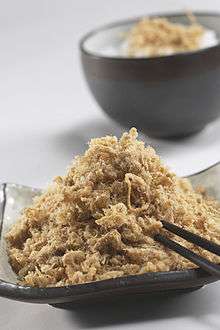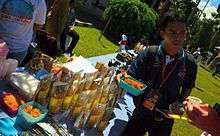Rousong
Rousong (pronounced [ɻôusʊ́ŋ]; Chinese: 肉鬆; Cantonese Yale: yuk6 sung1), also known as meat wool, meat floss, pork floss, beef floss, abon, pork sung or yuk sung, is a dried meat product with a light and fluffy texture similar to coarse cotton, originating from China.[1] Rousong is used as a topping for many foods, such as congee, tofu, and savory soy milk. It is also used as filling for various savory buns and pastries as well as a topping for baked goods filled with bean paste, for example, and as a snack food on its own. Rousong is a very popular food item in Chinese, Vietnamese (called ruoc) and Indonesian dining.
 | |
| Alternative names | Meat wool, meat floss, pork floss, flossy pork or pork sung |
|---|---|
| Place of origin | China[1] |
| Region or state | East Asia and Southeast Asia |
| Associated national cuisine | China, Vietnam and Indonesia |
| Main ingredients | Pork, beef, or chicken |
| Rousong | |||||||||||||||||
|---|---|---|---|---|---|---|---|---|---|---|---|---|---|---|---|---|---|
| Chinese name | |||||||||||||||||
| Traditional Chinese | 肉鬆 | ||||||||||||||||
| Simplified Chinese | 肉松 | ||||||||||||||||
| Literal meaning | meat fluff | ||||||||||||||||
| |||||||||||||||||
| Southern Min name | |||||||||||||||||
| Chinese | 肉酥 | ||||||||||||||||
| Literal meaning | meat flakes | ||||||||||||||||
| |||||||||||||||||
| Eastern Min name | |||||||||||||||||
| Traditional Chinese | 肉絨 | ||||||||||||||||
| Simplified Chinese | 肉绒 | ||||||||||||||||
| Literal meaning | meat fabric | ||||||||||||||||
| |||||||||||||||||
| Vietnamese name | |||||||||||||||||
| Vietnamese | ruốc (Northern Vietnamese) or chà bông (Southern Vietnamese) | ||||||||||||||||
| Thai name | |||||||||||||||||
| Thai | หมูหย็อง | ||||||||||||||||
| RTGS | mu yong | ||||||||||||||||
| Indonesian name | |||||||||||||||||
| Indonesian | abon | ||||||||||||||||
| Filipino name | |||||||||||||||||
| Tagalog | mahu or masang | ||||||||||||||||
Production
Rousong is made by stewing cuts of pork or beef in a sweetened soy sauce mixture until individual muscle fibres can be easily torn apart with a fork. This happens when the water-insoluble collagen that holds the muscle fibres of the meat together has been converted into water-soluble gelatine.[2] The meat is teased apart, strained, and partially dried in the oven. It is then mashed and beaten while being dry-cooked in a large wok until it is nearly completely dry. Additional flavourings are usually added while the mixture is being dry-fried. Five kilograms of meat will usually yield about 1 kg of floss.[3]
Other versions
 |
| Chinese cuisine |
|---|
|
|
Overseas cuisine |
|
Ingredients and types of food |
|
Fish can also be made into floss (魚鬆; yú sōng), though initial stewing is not required due to the low collagen and elastin content of fish meat. Rabbit and duck floss can also be found in China.[4][5]
In Muslim-majority Indonesia and Malaysia, beef or chicken floss is the most popular variant and is commonly called abon (Indonesian) or serunding (Malay). In Malaysia, serunding is a popular delicacy during Ramadan and Eid al-Fitr.[6]
In the Muslim-majority Hausa cuisine of Northern Nigeria, dambu nama is a dry, shredded beef snack, similar to rousong. It is fried and heavily spiced in its preparation.
A very similar product is pork fu (肉脯; pinyin: ròufǔ; Pe̍h-ōe-jī: bah-hú), which is less fried and less shredded than rousong, and has a more fibrous texture.
- Fish floss is roasted to look very much like its meat counterpart.
 Beef floss for sale in Sulawesi, Indonesia
Beef floss for sale in Sulawesi, Indonesia
Health
A study has demonstrated a positive correlation between increased processing temperatures of rousong and increased formation of heterocyclic aromatic amines (HAAs) within the meat. Up to seven different HAAs were found when rousong was processed at 150°C.[7] HAAs are believed to promote the development of some cancers.[8]
See also
References
- Grigson, Jane (January 1985), World Atlas of Food, Bookthrift Company, ISBN 978-0-671-07211-7
- Vickie Vaclavik, Elizabeth W. Christian. "Essentials of Food Science". Springer, 2003, p. 169.
- Melia, Ken (2017). Review of Meat Floss – Identifying opportunities for Australian Red Meat. North Sydney: Meat and Livestock Australia Limited
- Zhou, Zhen (2017). "Research of new duck floss with spicy flavor" Food and Fermentation Technology: 120–125 – via Food Science and Technology Abstracts.
- Leistner, Lothar (2002). Hurdle Technologies: Combination Treatments for Food Stability, Safety and Quality. New York: Kluwer / Plenum Publishers. pp. 132, 139. ISBN 978-1-4613-5220-4.
- Thestar.com. "Thestar.com." Mum’s meat floss legacy. Retrieved on 2008-09-19.
- Liao, Guozhou (April 2009). "Effects of Cooked Temperatures and Addition of Antioxidants on Formation of Heterocyclic Aromatic Amines in Pork Floss". Journal of Food Processing and Preservation. 33: 159–175. doi:10.1111/j.1745-4549.2008.00239.x – via Web of Science.
- Weisburger, John H. (2002-09-30). "Comments on the history and importance of aromatic and heterocyclic amines in public health". Mutation Research. 506-507: 9–20. doi:10.1016/s0027-5107(02)00147-1. ISSN 0027-5107. PMID 12351140.
